- News
- Reviews
- Bikes
- Accessories
- Accessories - misc
- Computer mounts
- Bags
- Bar ends
- Bike bags & cases
- Bottle cages
- Bottles
- Cameras
- Car racks
- Child seats
- Computers
- Glasses
- GPS units
- Helmets
- Lights - front
- Lights - rear
- Lights - sets
- Locks
- Mirrors
- Mudguards
- Racks
- Pumps & CO2 inflators
- Puncture kits
- Reflectives
- Smart watches
- Stands and racks
- Trailers
- Clothing
- Components
- Bar tape & grips
- Bottom brackets
- Brake & gear cables
- Brake & STI levers
- Brake pads & spares
- Brakes
- Cassettes & freewheels
- Chains
- Chainsets & chainrings
- Derailleurs - front
- Derailleurs - rear
- Forks
- Gear levers & shifters
- Groupsets
- Handlebars & extensions
- Headsets
- Hubs
- Inner tubes
- Pedals
- Quick releases & skewers
- Saddles
- Seatposts
- Stems
- Wheels
- Tyres
- Health, fitness and nutrition
- Tools and workshop
- Miscellaneous
- Tubeless valves
- Buyers Guides
- Features
- Forum
- Recommends
- Podcast
review
£9,750.00
VERDICT:
Incredible performance – if you can afford it
Weight:
7,150g
Contact:
At road.cc every product is thoroughly tested for as long as it takes to get a proper insight into how well it works. Our reviewers are experienced cyclists that we trust to be objective. While we strive to ensure that opinions expressed are backed up by facts, reviews are by their nature an informed opinion, not a definitive verdict. We don't intentionally try to break anything (except locks) but we do try to look for weak points in any design. The overall score is not just an average of the other scores: it reflects both a product's function and value – with value determined by how a product compares with items of similar spec, quality, and price.
What the road.cc scores meanGood scores are more common than bad, because fortunately good products are more common than bad.
- Exceptional
- Excellent
- Very Good
- Good
- Quite good
- Average
- Not so good
- Poor
- Bad
- Appalling
This is the brand new Specialized S-Works Venge, the company's third-generation aero road bike, and it's faster, lighter, stiffer, better handling, easier to adjust and better looking than the old Venge ViAS. If you crave speed, this is the bike for you. There's just the small matter of the massive price tag, but this is the pinnacle of aerodynamic road race bike design.
- Pros: Speed, handling, brakes, spec, fit adjustment, looks
- Cons: The price
Ride and handling
Wow, this bike is seriously quick! That's my overwhelming and lasting impression of riding the S-Works Venge, without doubt one of the fastest, if not the fastest, road bikes I have ever ridden.
Obviously how fast you go on a bicycle comes down to what you have in the legs, but what impresses about the Venge is the way it translates all the power you've got into speed in a way that few bikes I've ridden can match.
> Find your nearest dealer here
It builds speed quickly and the speed keeps on coming, seemingly effortlessly. Measuring power and heart rate and riding familiar test loops, I was frequently faster at all power levels. I set a raft of new PBs, often without really even trying. If I was still racing, this is the bike I would want to be on.
There's more to the new Venge than raw speed. What also impresses is how Specialized has eradicated the compromises that have plagued previous aero bikes. It's impressively smooth and tolerant of rough roads, the handling is superb and the fit is easy to adjust.
In some ways, it feels like a sharper and edgier version of Specialized's Tarmac SL6, a little firmer on the road with a smidgen more feedback through the contact points perhaps, but there's a similarity in how well the bike turns and handles. This is good because the latest Tarmac is one of my standout bikes this year.
Comfort isn't usually a word that crops up when talking about aero bikes, other than to comment on its absence. Aero bikes are designed for speed and nothing else, and those deep profiled tube shapes aren't the best for helping a bike deal with bumps and cracks. Not so with the new Venge, it utterly impressed with its ability to remain composed on the roughest of my local roads.
Granted, it's nowhere near as smooth as the Cannondale Synapse or Trek Domane, but the gap has narrowed significantly. I've ridden aero bikes that are so harsh they are tiring to ride, leaving you feeling exhausted. The Venge provides enough comfort that I could finish every ride, even the longest all-dayers, with no aches or pains. Well, none more so than usual anyway!
The composure it displays over poorly surfaced roads is incredible for an aero bike. There's no overwhelming feedback from the handlebar or saddle, it doesn't bounce and skip over jagged edges of broken tarmac or freak out when you show it a scarred road surface. It's like a firmer version of the Tarmac SL6. I reckon a switch to shallow wheels would free up a bit more compliance, and with the capacity for up to 32mm tyres, more comfort could be squeezed out here too if you really wanted it.
The weight that Specialized has chopped out of the frame – a whopping 240g, with a size 56cm frame weighing a claimed 960g – gives the bike a more all-round appeal so it is just as good on a long, hilly route as it is flying around a flat criterium circuit. With the bike's all-in weight of 7.1kg, you're not exactly facing a massive handicap riding in the hills and mountains. Out-of-the-saddle climbing reveals the stiffness improvements in the new handlebar and stem, and the frame doesn't waste any of your watts at all.
Frame and equipment
There's nothing in common with the old Venge ViAS, this new third-generation Venge is a brand new bike, designed from the ground up using Specialized's own computer software to model the tube shapes and extensively tested in its very own wind tunnel. This level of investment shows in the vast improvement, both visual and claimed, of the bike.
It looks fast, and it is fast, Specialized claiming it's 8 seconds faster than the old Venge over 40km at 0-degree yaw. Doesn't sound like much, but where the previous Venge was aerodynamic at all costs, the new bike is a much more considered design with a focus on weight, handling and adjustment, and given how small a part the bike plays in your overall drag as rider and bike, the improvement is pretty impressive.
Specialized actually started designing the new Venge by first developing its own Free Shape Optimisation software that could generate millions of tube shapes and analyse them based on aerodynamics, surface area and stiffness. Specialized didn't just take a tube profile off the shelf, it wanted to develop tube shapes that met its particular requirements. Chris Yu, director of Integrated Technologies at the company, describes this as the company's trump card.
To my eyes, it's a much better looking bike, too. Yes, looks are subjective, but I reckon you'll agree with me. The curvy down tube has been replaced by an arrow-straight one, there's a new semi-integrated handlebar and stem, and all-new seat stays that are dropped just like they are on the Tarmac, topped off with an aero seatpost.
As well as being more aero, the big news is that the new Venge is designed entirely around disc brakes and only compatible with electronic gears. The latter makes perfect sense, considering this is a bike designed for racers and all the pros use electronic gears (mostly Shimano Dura-Ace Di2) and has allowed Specialized to avoid any concessions to mechanical cable routing.
The decision to only support disc brakes reflects the way the market is going, with Specialized telling us more of its customers are choosing disc brakes, and the benefits of disc brakes far outweigh any negatives. You might think there's a negative impact on the aerodynamic performance but Specialized says that's not the case, with gains made from the removal of the rim brakes offsetting any drag the discs might cause.
Massively changed on the new Venge is the all-new aero handlebar and stem. It's a two-piece design and the good news is you can swap out both for any other piece of standard equipment if you like, you're not tied into a proprietary system. That's good news for adjusting the bike for your fit and making changes without buying a whole new handlebar and stem.
The new Aerofly II handlebar is not only better looking than the bendy bar on the previous Venge, it's also lighter, stiffer and more aero. It contributes hugely to the improved ride feel of the bike, with much more positive steering and direct handling noticeable. My only gripe is that you can't ride comfortably on the tops for extended periods, but then this isn't a bike for cruising along and admiring the countryside, it's a bike for blatting along as fast as possible down in the drops.
Specialized claims the new stem is stiffer than any it has tested on the market, including Peter Sagan's favourite, the Zipp SL Sprint (which he has previously fitted to his race bikes with the logos taped over), and boy can you detect this improvement when sprinting out of the saddle compared with the old Venge, which felt like a wet flannel in comparison to this new bike. You can adjust the stack height by adding or removing the aero spacers – if I was buying this bike I'd probably remove a couple and trim the steerer tube.
The new stem and handlebar also feature very neat internal routing for the brake hoses and gear wires, which pass through the handlebar, underneath the stem and into the frame. It's very tidily packaged, and relatively easy to disassemble for packing the bike for flying. I took the Venge to Nice for a weekend of cycling and had no problems fitting it all into a hard bike case.
The new stem and bar come in a wide variety of sizes. The 6-degree stem comes in 80, 90, 100, 110, 120 and 130mm lengths, and the 12-degree version comes in 110, 120, 130 and 140mm. The Aerofly II handlebars come in four widths from 380 to 440mm. There are computer mounts for floating a Garmin or Wahoo computer out front as well.
The new Venge also uses the Rider-First Engineered approach found across the rest of the Specialized range, and through feedback from the pros and amateurs and lots of data collection, and tuning the carbon layup, each frame size offers the perfect ride, no compromises.
The focus is on delivering the same fit as the Tarmac SL6. Compare geometry charts and you'll notice the reach and stack are subtly different, but the same fit is achieved through different height headset cones and spacers. Ideal if you're swapping from one bike to another.
Disc brake standards have thankfully settled down and the Venge uses the flat mount interface with a 142x12mm rear axle and 100x12mm front. By default, the Venge comes with bolt-on axles requiring a 6mm Allen key, which at a claimed 67g/pair are half the weight of standard quick release axles. DT RWS ratcheting handles are available if you prefer tool-free wheel removal.
Equipment
The S-Works Venge costs £9,750.
Sunk in yet? Probably not, it's a big pile of cash. You do, however, get a very good specification with a power meter included and a frame, fork and handlebar that is as state-of-the-art as it's possible to get right now. There's nothing you'd need to change.
A Shimano Dura-Ace Di2 R9170 groupset forms the basis of the build and it's flawless. With sharp and quick shifting, and powerful brakes with great lever feel and fantastic ergonomics, it sets the standard by which all other groupsets are measured.
The Di2 junction box has been relocated to the back of the seatpost saddle clamp, after feedback from the pros. The main benefit is that it allows team mechanics to access it more easily when leaning out of a car window than if it were located in the down tube or handlebar.
Specialized's own S-Works carbon crankset with Praxis aluminium chainrings is the only departure from the Shimano theme, but it feels as stiff as Dura-Ace and the shifting performance is first class. It's also packing an integrated dual-sided power meter, the first for the company but based on tried-and-tested 4iiii technology. It worked seamlessly with Garmin and Wahoo computers and proved to be accurate and consistent during a month of use and tested against PowerTap P1 pedals. No complaints.
Roval's CLX64 wheels enhance the speed of the bike and sound fantastic when you're sprinting. They are susceptible to gusty crosswinds so might cause concern if you live somewhere hilly and windy. I found some fast descents in Nice accompanied by strong winds to be a bit of a handful on occasions, but it's manageable. The rims are tubeless-ready and the aluminium hub shells are packing high-quality DT Swiss 240 internals with CeramicSpeed bearings.
The 26mm wide Turbo Cotton tyres offer splendid performance, too. I do really like these tyres. They are fast with low rolling resistance and good levels of grip in the dry and rain, and the suppleness from the 320 TPI casing gives a silky smooth ride. The only downside is that they do wear quickly, a trade-off for a fast and light race tyre. And those tan/gum sidewalls absolutely rock!
Conclusion
I love this bike. It's not often that I say that about a test bike. But the speed, the handling, comfort, the ease of fit adjustment, the integration of the handlebar and internal cabling, the high-quality spec, not to mention the jaw-dropping looks, all create a stunning display of design and engineering.
If you're a fan of going fast and have deep pockets, you'll adore the S-Works Venge. If it was my money, well I'd buy the slightly more affordable Ultegra Di2 model because it wouldn't take me as long to save up for it (though it would still take bloody ages) because it basically gets the same frame and handlebar with slightly different wheels, and enjoy the performance and the savings.
> Buyer's Guide: The hottest aero road bikes of 2019
The aero road bike category has been an exciting one to watch this year, and there are a few contenders that I'd very much like to ride. There's the brand new Cannondale SystemSix (£3,499.99-£8,499.99), the disc-equipped Trek Madone (£5,500-£10,550), and the stunning new Cervelo S5 Disc (£4,899-£9,699). For now, though, the S-Works Venge is the aero bike to beat.
Verdict
Incredible performance – if you can afford it
road.cc test report
Make and model: Specialized S-Works Venge Di2
Size tested: 56cm
About the bike
List the components used to build up the bike.
FRAME S-Works FACT 11r carbon, Rider-First Engineered™, Win Tunnel Engineered, internal electric only cable routing, OSBB, 12x142mm thru-axle, flat-mount disc
FORK S-Works FACT 11r carbon, 100x12mm thru-axle, flat-mount disc
BOTTOM BRACKET OSBB, CeramicSpeed bearings
CHAIN Shimano Dura-Ace, 11-speed
CRANKSET S-Works Power Cranks, dual-sided power measurement, +/- 1.5% accuracy
SHIFT LEVERS Shimano Dura-Ace Di2 Disc R9170
FRONT DERAILLEUR Shimano Dura-Ace Di2 R9150, braze-on
CASSETTE Shimano Dura-Ace 9100, 11-speed, 11-28t
CHAINRINGS 52/36T
REAR DERAILLEUR Shimano Dura-Ace Di2 R9150, 11-speed
SADDLE S-Works Power, 143mm, carbon rails, carbon base, synthetic leather
SEAT BINDER Venge integrated two-piece wedge
TAPE S-Wrap Roubaix bar tape
HANDLEBARS S-Works Aerofly II, 80mm reach x 130mm drop
REAR WHEEL Roval CLX 64 Disc, carbon, tubeless-ready, Win Tunnel Engineered, 64mm depth, DT Swiss 240 internals, CeramicSpeed bearings, 24h
INNER TUBES Presta, 80mm valve
FRONT TIRE Turbo Cotton, 320 TPI, 700x26mm
REAR TIRE Turbo Cotton, 320 TPI, 700x26mm
FRONT WHEEL Roval CLX 64 Disc rim, Roval AFD1, Center Lock™, CeramicSpeed bearings, 21h
FRONT BRAKE Shimano Dura-Ace R9170, hydraulic disc
REAR BRAKE Shimano Dura-Ace R9170, hydraulic disc
PEDALS Nylon, 105x78x28mm, loose ball w/ reflectors
Tell us what the bike is for and who it's aimed at. What do the manufacturers say about it? How does that compare to your own feelings about the bike?
Specialized says:
We aren't satisfied with second fastest. Hell, why do you think we have our own Win Tunnel and the motto, "Aero is Everything?" We live and breathe aero, because we know that aerodynamic optimization is the best thing we can do to make you faster. And this philosophy has never been truer than with the new Venge. Being eight seconds faster than the ViAS, it's not only the most aerodynamic bike on the road, but it's also lost 460 grams. This is the new shape of speed.
Surprisingly, our quest for the perfect tube shapes didn't start in the Win Tunnel. It started with a new piece of technology, the FreeFoil Shape Library. Our engineers wrote an optimization algorithm and utilized a supercomputer (yes, we used an actual supercomputer) to help create new airfoil shapes with different weights, surface areas, and structural targets. Armed with this library of shapes, all with different aspect ratios, we could plug them into the different parts of the bike and test a variety of configurations to determine the fastest setup in the Win Tunnel.
Compared to the fastest aero road bike to date (the Venge ViAS), and many others in the space that we won't name here, the new Venge is eight seconds faster over 40km at zero degrees of yaw. It's also faster out on the road in all wind conditions - not just in the tunnel.
And while it's cool that the new Venge is more aero, there are other factors to fast. Striking the perfect combination of weight and aerodynamics plays a crucial role in a bike's overall performance. A bike that's strictly aero will feel great on the flats, but it'll suffer on the climbs and in quick accelerations. A bike that's strictly lightweight, however, will suffer on everything but the steepest climbs. So, not only did we make the Venge more aero than the ViAS, but we also took 460 grams out of the module weight. This means we saved 240g in the frame, 25g in the fork, 107g in the cockpit, 25g in the seatpost, and 63g in small parts. So no matter the course, the Venge will prove to be the fastest option when you need to go up, down, and all around.
Much of this weight savings comes from our Rider-First Engineered™ tubes. We implemented much of the discovery from the new Tarmac's development, like different layup schedules and materials, and this culminated in a Venge that's not only lighter, but one that also has a higher stiffness-to-weight ratio and 40% more compliance than the ViAS - no matter the frame size. And while you can't always see these changes, all it takes is one ride to feel the quick accelerations and the bump-eating compliance.
Of course, we didn't stop there. The geometry got an update, and now, it's based on over 40,000 Retül data points, as well as professional rider input. This enabled us to implement a Performance Road Geometry that perfectly combines a responsive front-end with a short wheelbase, and this delivers instantaneous response and optimal power transfer.
Last, but certainly not least, the Venge houses some exciting new features. The new cockpit, developed in partnership with our World Tour teams, features a stem with a higher stiffness than anything we've ever tested, new bars that are faster, lighter, stiffer, and feature a textured pattern on the tops for extra grip and control. Next up is tire clearance''it has no problem clearing 32mm-wide tires. And, finally, we've put our Shimano A-Junction in the seatpost, making it easy to charge, check battery levels, and for team mechanics to make adjustments.
The S-Works Venge comes with the best components spec around, with Shimano Dura-Ace Di2, hydraulic disc brakes, Roval CLX 64 Disc wheels dressed with 700x26mm Turbo Cotton Tires, and our S-Works Power Cranks that are the lightest & most accurate in the world.
Where does this model sit in the range? Tell us briefly about the cheaper options and the more expensive options
Right at the top! You'd think... unless you want a fancy Sagan paint job cos that'll cost you £10,250. There's one cheaper option, the Venge Pro, a snip at £6,500.
Frame and fork
Overall rating for frame and fork
9/10
Tell us about the build quality and finish of the frame and fork?
Impressive engineering and attention to detail.
Tell us about the materials used in the frame and fork?
S-Works FACT 11r carbon, Rider-First Engineered, Win Tunnel Engineered, internal electric only cable routing, OSBB, 12x142mm thru-axle, flat-mount disc
Tell us about the geometry of the frame and fork?
Aggressive and designed for racing.
Specialized says, "The geometry got an update, and now, it's based on over 40,000 Retül data points, as well as professional rider input. This enabled us to implement a Performance Road Geometry that perfectly combines a responsive front-end with a short wheelbase, and this delivers instantaneous response and optimal power transfer."
How was the bike in terms of height and reach? How did it compare to other bikes of the same stated size?
I found the fit perfect. If I was buying the bike I'd probably drop out a few of the stem spacers.
Riding the bike
Was the bike comfortable to ride? Tell us how you felt about the ride quality.
Compared to all previous aero race bikes, yes it was comfortable to ride.
Did the bike feel stiff in the right places? Did any part of the bike feel too stiff or too flexible?
The new handlebar and stem gives the front end way more stiffness than the old Venge, with a much more direct feeling when steering through bends.
How did the bike transfer power? Did it feel efficient?
It's very efficient at transferring your watts to forward motion, whether sprinting for a finish line or out-of-the-saddle climbing.
Was there any toe-clip overlap with the front wheel? If so was it a problem?
None.
How would you describe the steering? Was it lively neutral or unresponsive? Responsive and direct.
Tell us some more about the handling. How did the bike feel overall? Did it do particular things well or badly?
The handling works well in fast-paced racing groups or more relaxed solo rides; it's very involving and exciting to ride.
Which components had the most effect (good or bad) on the bike's comfort? would you recommend any changes?
There's nothing I'd change at all.
Which components had the most effect (good or bad) on the bike's stiffness? would you recommend any changes?
If you were really wanting to max the comfort you could fit wider tyres.
Which components had the most effect (good or bad) on the bike's efficiency? would you recommend any changes?
If you live someplace very windy you might consider a shallower wheelset.
Rate the bike for efficiency of power transfer:
9/10
Rate the bike for acceleration:
10/10
Rate the bike for sprinting:
10/10
Rate the bike for high speed stability:
9/10
Rate the bike for cruising speed stability:
9/10
Rate the bike for low speed stability:
9/10
Rate the bike for flat cornering:
9/10
Rate the bike for cornering on descents:
9/10
Rate the bike for climbing:
7/10
The drivetrain
Rate the drivetrain for performance:
8/10
Rate the drivetrain for durability:
8/10
Rate the drivetrain for weight:
8/10
Rate the drivetrain for value:
7/10
Wheels and tyres
Rate the wheels for performance:
9/10
Rate the wheels for durability:
8/10
Rate the wheels for weight:
7/10
Rate the wheels for comfort:
7/10
Rate the wheels for value:
8/10
Rate the tyres for performance:
9/10
Rate the tyres for durability:
7/10
Rate the tyres for weight:
8/10
Rate the tyres for comfort:
8/10
Rate the tyres for value:
8/10
Controls
Rate the controls for performance:
9/10
Rate the controls for durability:
8/10
Rate the controls for weight:
8/10
Rate the controls for comfort:
7/10
Rate the controls for value:
8/10
Tell us some more about the controls. Any particularly good or bad components? How would the controls work for larger or smaller riders?
My only small gripe is that the flats aren't very comfortable for cruising along on the tops.
Anything else you want to say about the componentry? Comment on any other components (good or bad)
The components are all top class.
Your summary
Did you enjoy riding the bike? Yes
Would you consider buying the bike? Yes
Would you recommend the bike to a friend? Yes
How does the price compare to that of similar bikes in the market, including ones recently tested on road.cc?
Yes it's expensive, but comparably priced with rival top-end aero bikes such as the brand new Cannondale SystemSix (£8,499.99) and stunning new Cervelo S5 Disc (£9,699), and cheaper than the Trek Madone (£10,550).
Rate the bike overall for performance:
10/10
Rate the bike overall for value:
7/10
Use this box to explain your overall score
It's a fantastic, fast and highly capable aero race bike that isn't compromised in comfort, handling and fit adjustment. That price though...
About the tester
Age: 31
I usually ride: My best bike is:
I've been riding for: 10-20 years I ride: Every day I would class myself as: Expert
I regularly do the following types of riding: road racing, time trialling, cyclo-cross, commuting, touring, mountain biking
David worked on the road.cc tech team from 2012-2020. Previously he was editor of Bikemagic.com and before that staff writer at RCUK. He's a seasoned cyclist of all disciplines, from road to mountain biking, touring to cyclo-cross, he only wishes he had time to ride them all. He's mildly competitive, though he'll never admit it, and is a frequent road racer but is too lazy to do really well. He currently resides in the Cotswolds, and you can now find him over on his own YouTube channel David Arthur - Just Ride Bikes.
Latest Comments
- a1white 7 hours 20 min ago
Absolutely loving the look of this. What a beauty!
- David9694 7 hours 26 min ago
First para bit of a bitter pill. When you're in a public service with an enforcement power, people will try in all sorts of ways, to play you. You...
- richliv 7 hours 40 min ago
Dunno if this thread is really still live as its dated 2021 but I'll assume its reanimated so......
- wtjs 7 hours 57 min ago
What's really important for us is that incidents involving cyclists are reported to us," she said. "We know from working with various cycling...
- ktache 8 hours 17 min ago
Torx is the future, it will slowly replace hex, much as my bicycle now lacks 10mm spanner heads, or screw heads, (apart from the JIS Shimano...
- ktache 8 hours 34 min ago
The better half was driving us down the M3 as it was becoming a "smart" motorway, 50mph average enforcement, everyone at the same speed, no lane...
- slitemere 9 hours 12 min ago
So sad that there is no 11 speed cable operated brake option what about the retro market for people who want to update their old rim brake frames?...
- Gbjbanjs 11 hours 12 min ago
I think you are right about being too close to the vehicle in front. However, the fact that the lead rider had to take evasive action to avoid a...
- anke2 11 hours 24 min ago
Check their website. These "inventors" run a social media agency and seem to make most (startup) money from a business selling pictures/movies of...
- mdavidford 11 hours 31 min ago
You said you agree with Councillor Bates, whose case is that there is £80k of active travel budget for Dyffryn Ceiriog and no active travel...



















































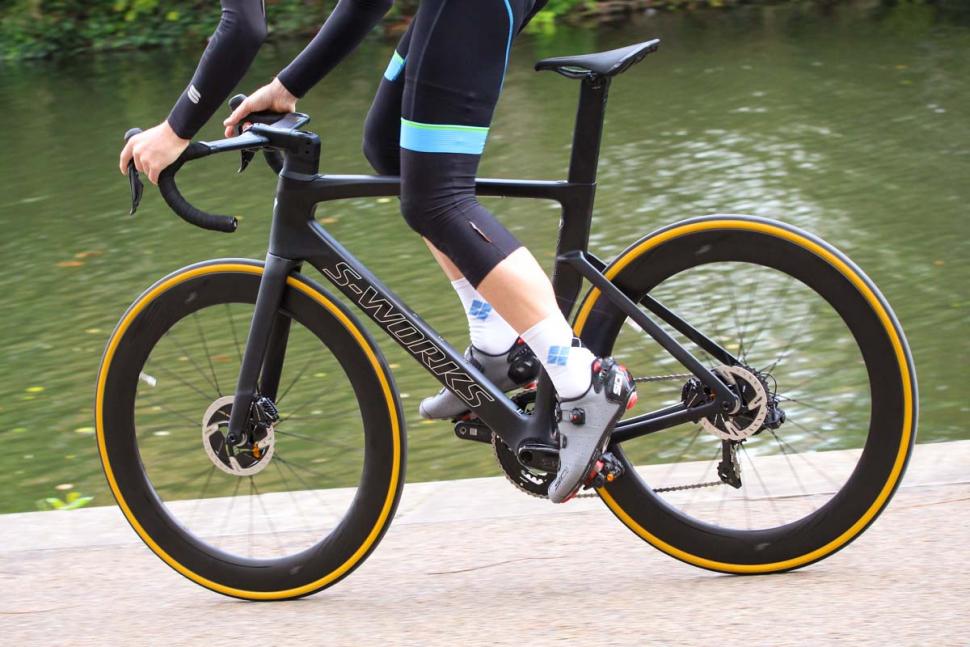
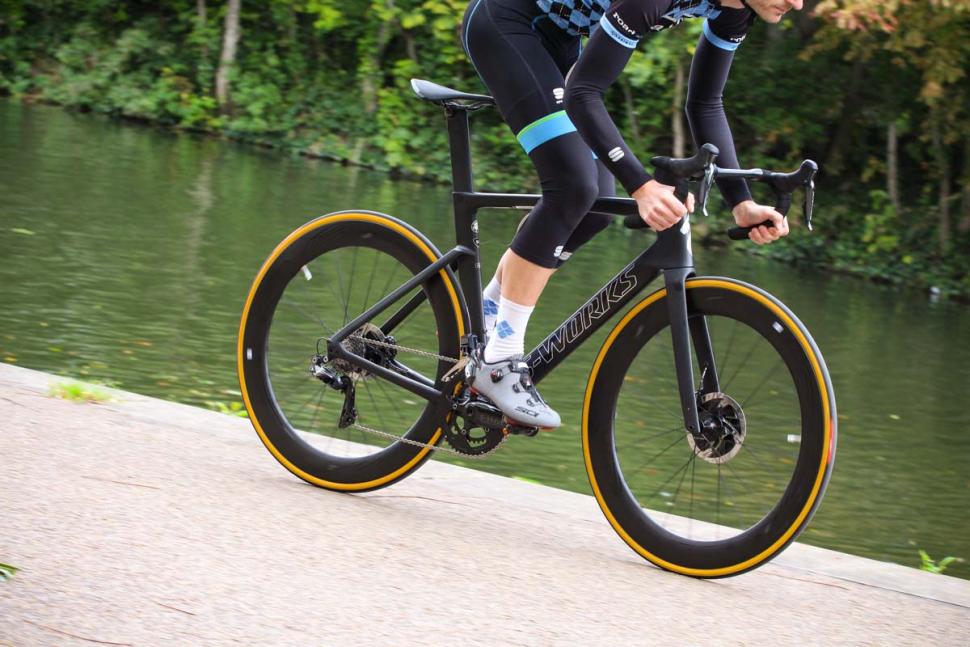
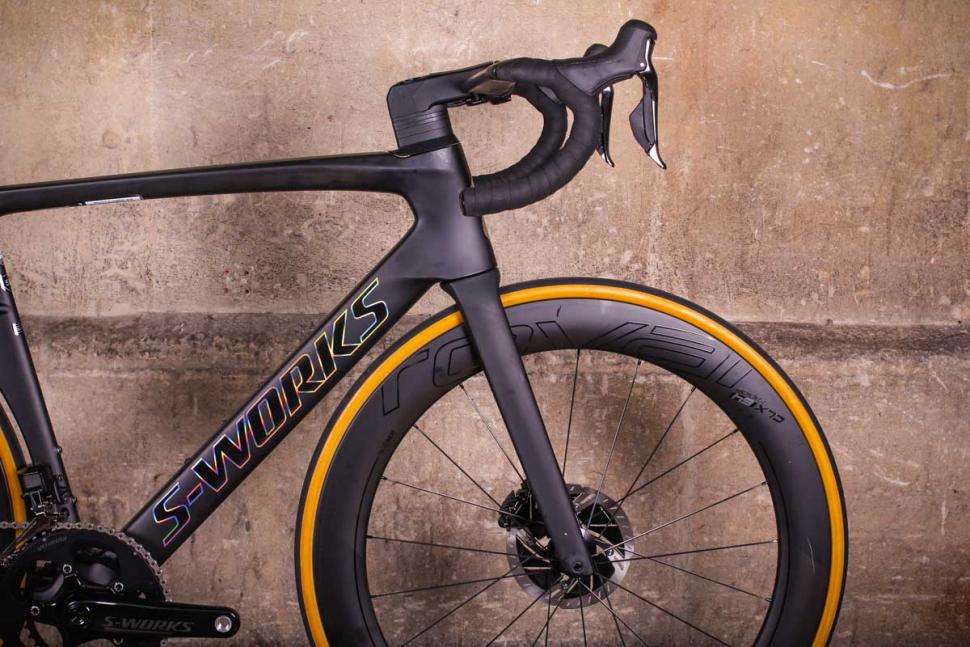
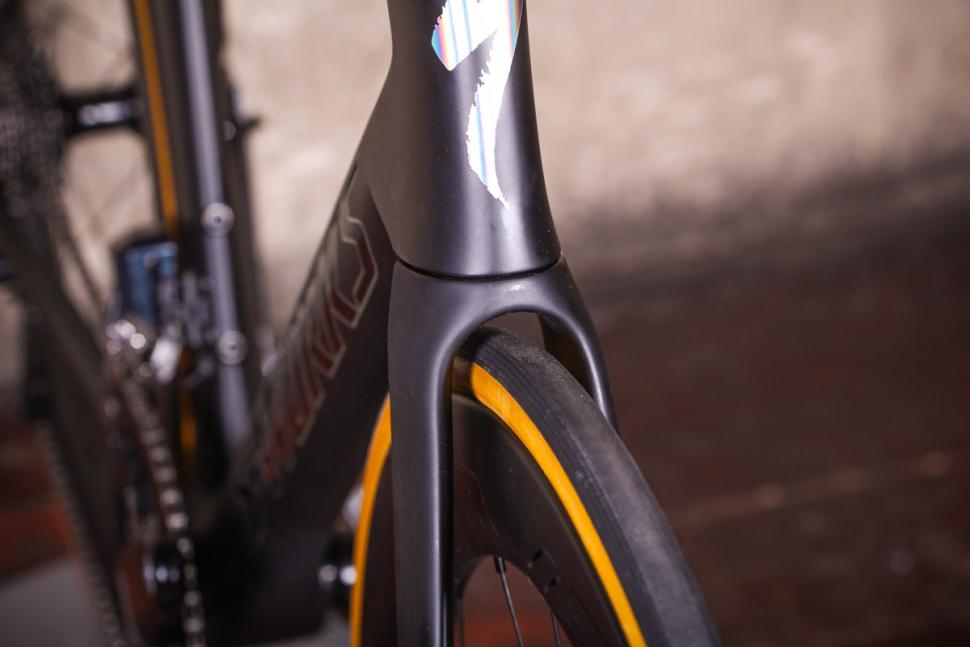
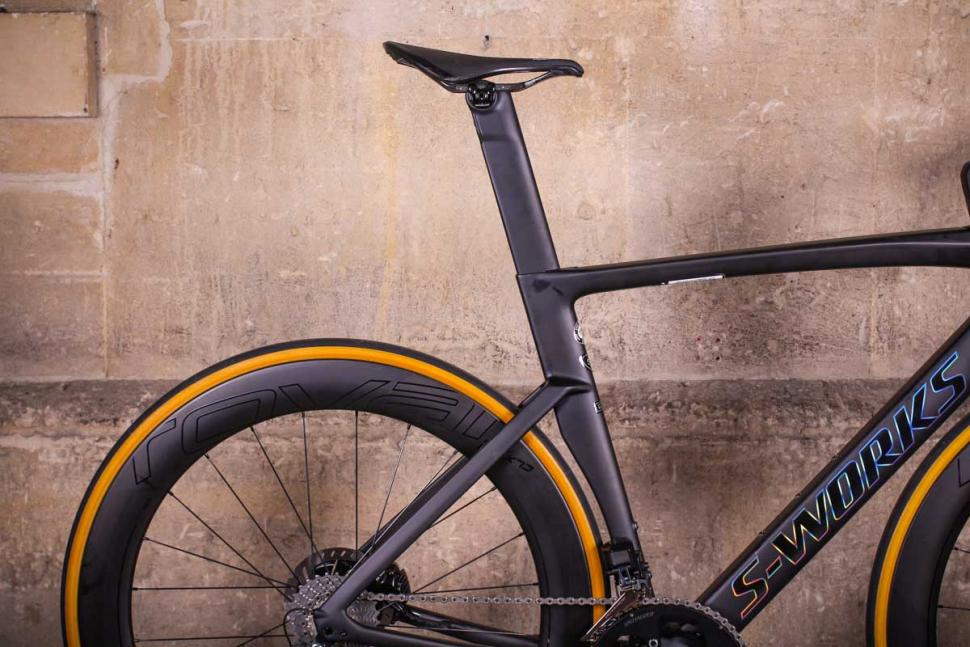

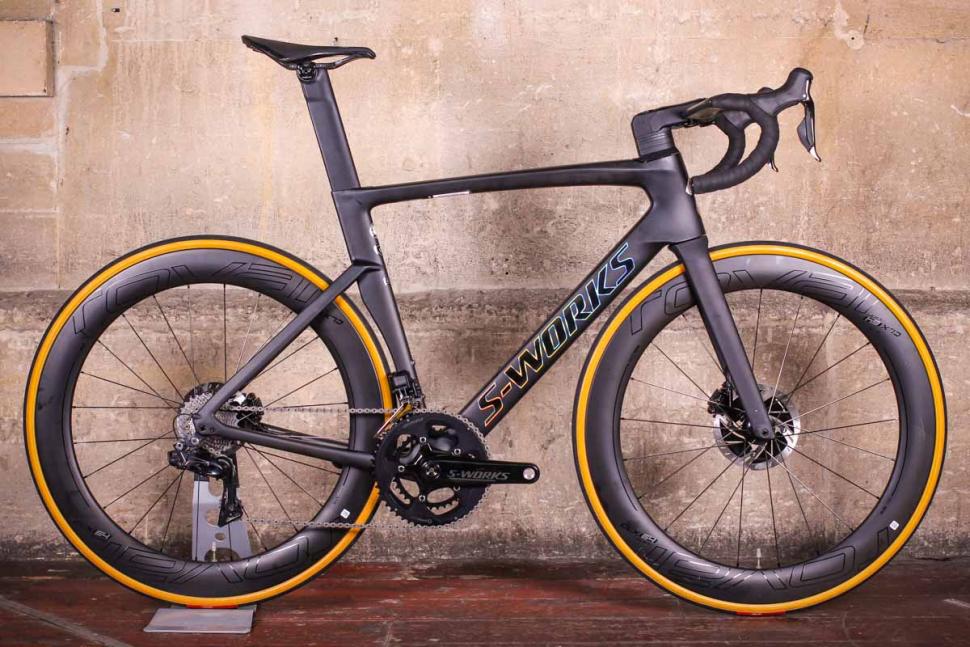

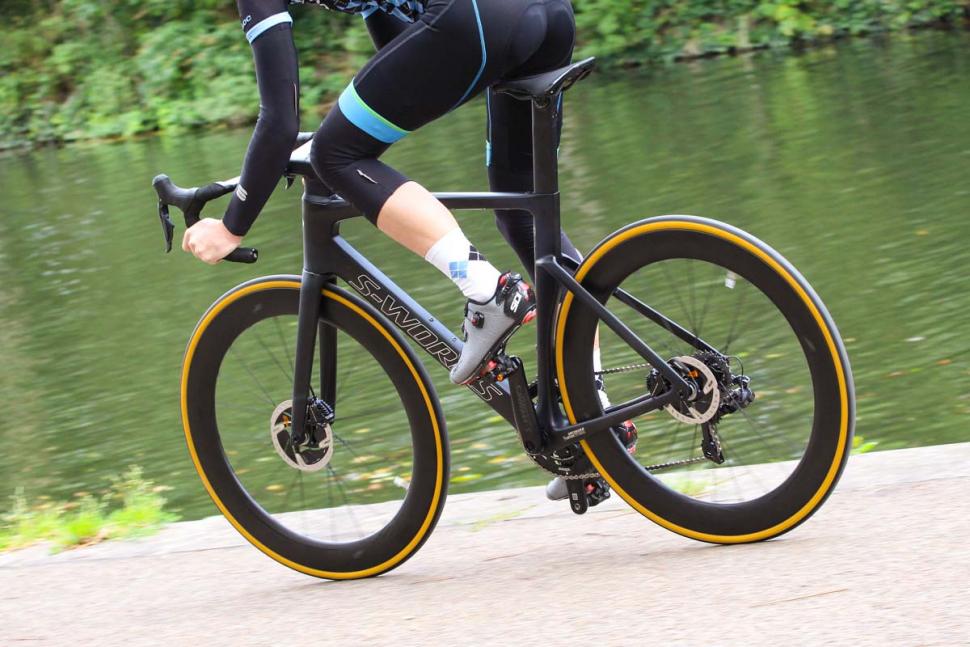
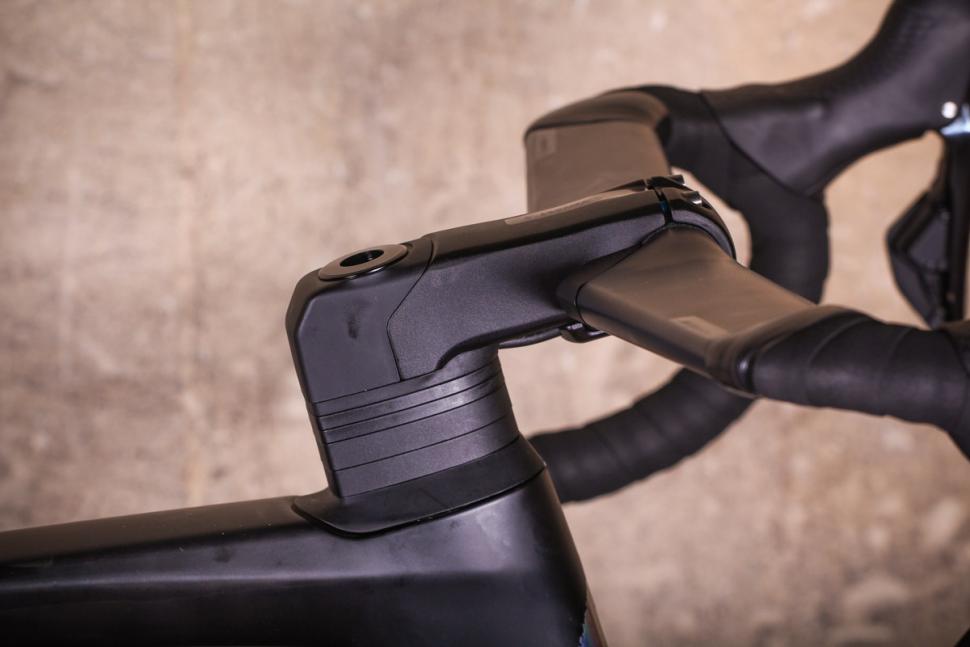
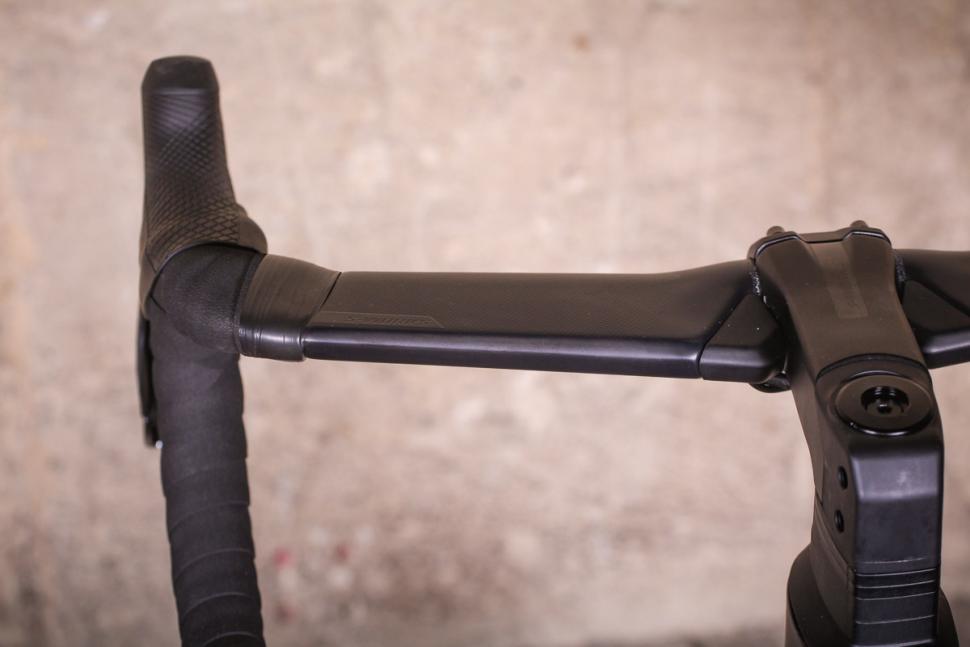
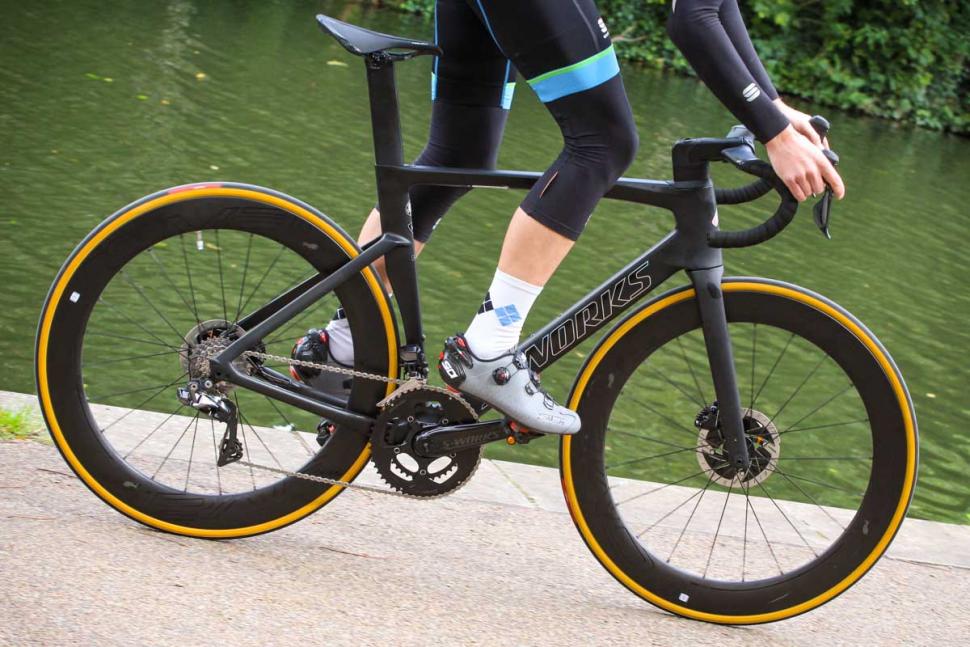
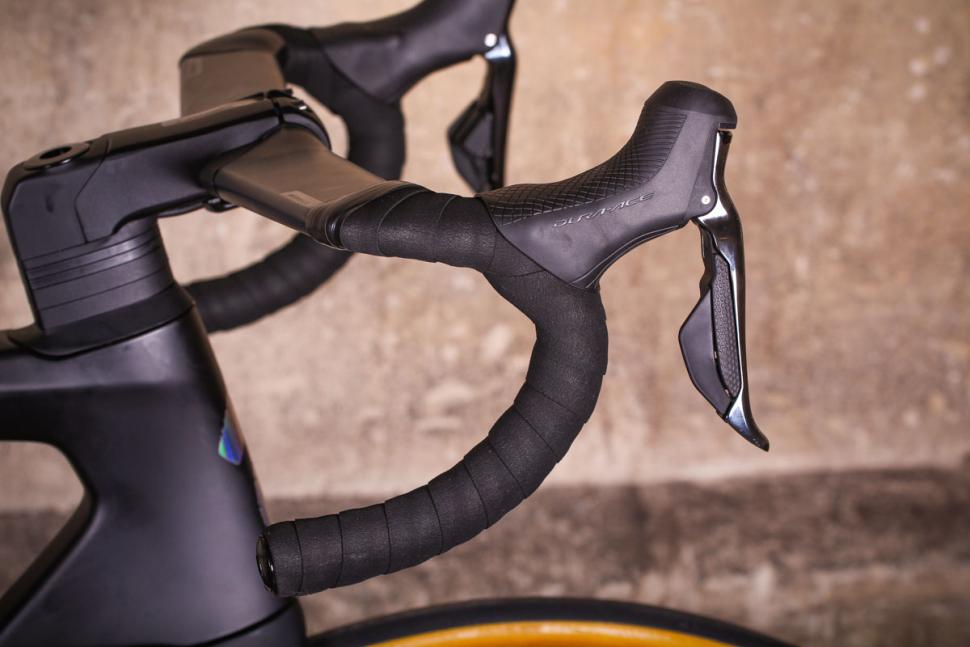
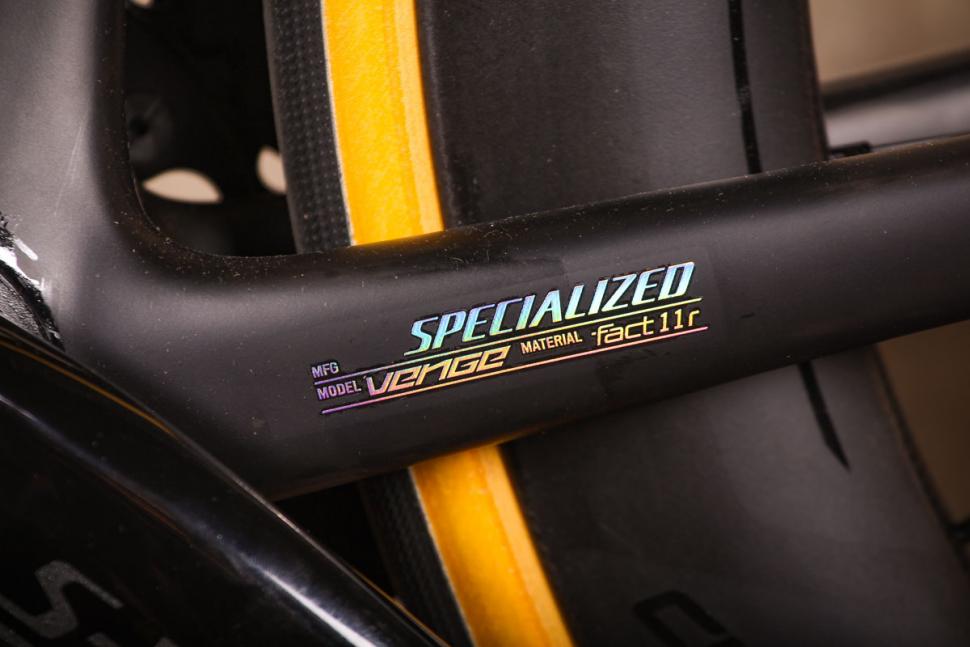
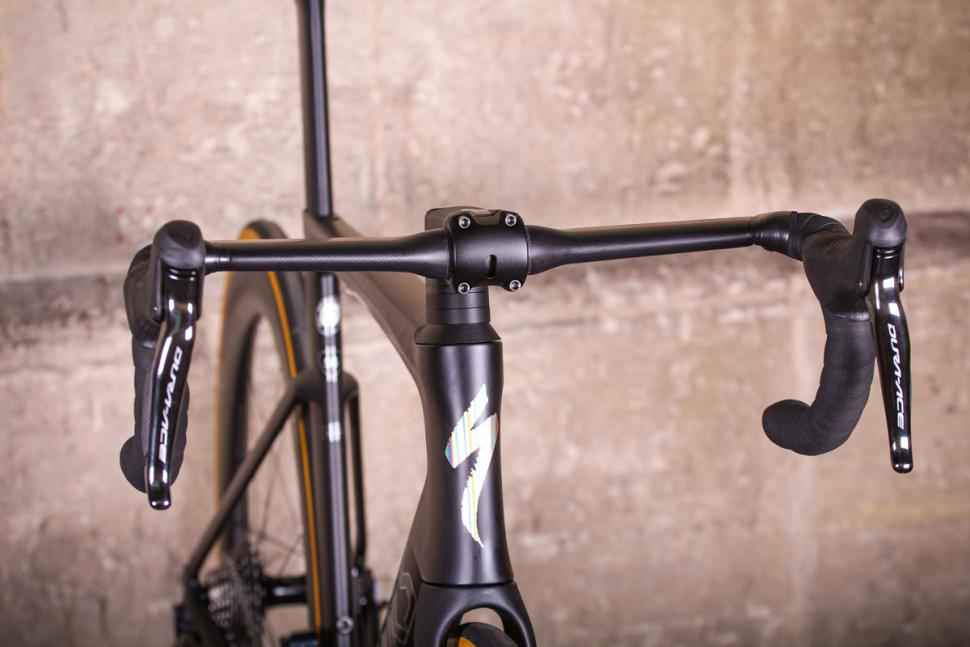


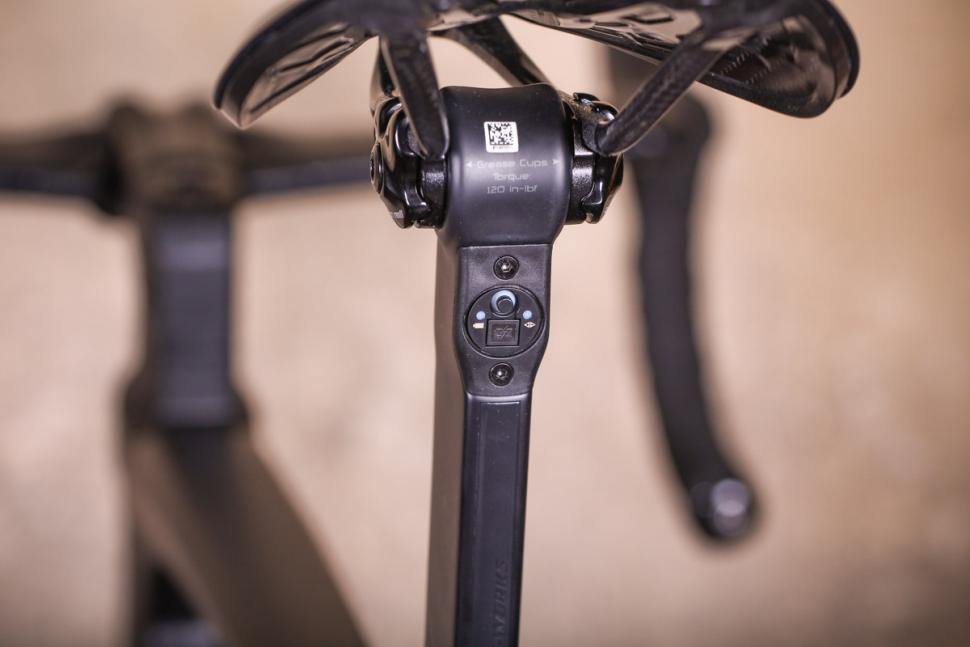





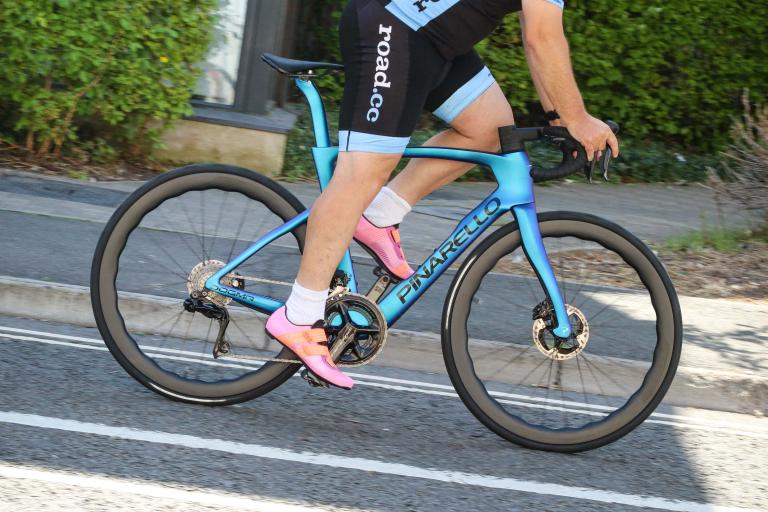

Add new comment
3 comments
30-32mm tyres would make a more comfortable ride but they'd also wipe out the aero advantage of the wheels. For a bike that's all about aerodynamics it seems counterintuative to put wide tyres on it.
The CLX64 are 30mm wide externally so you can probably go wider than 26 without ruining the aero. I'm not a fan of gumwall tyres and as the wheels are tubeless ready the new 28mm GP5000S would be my choice. Ahh....dreaming
Wow!
<Wipes drool from keyboard>